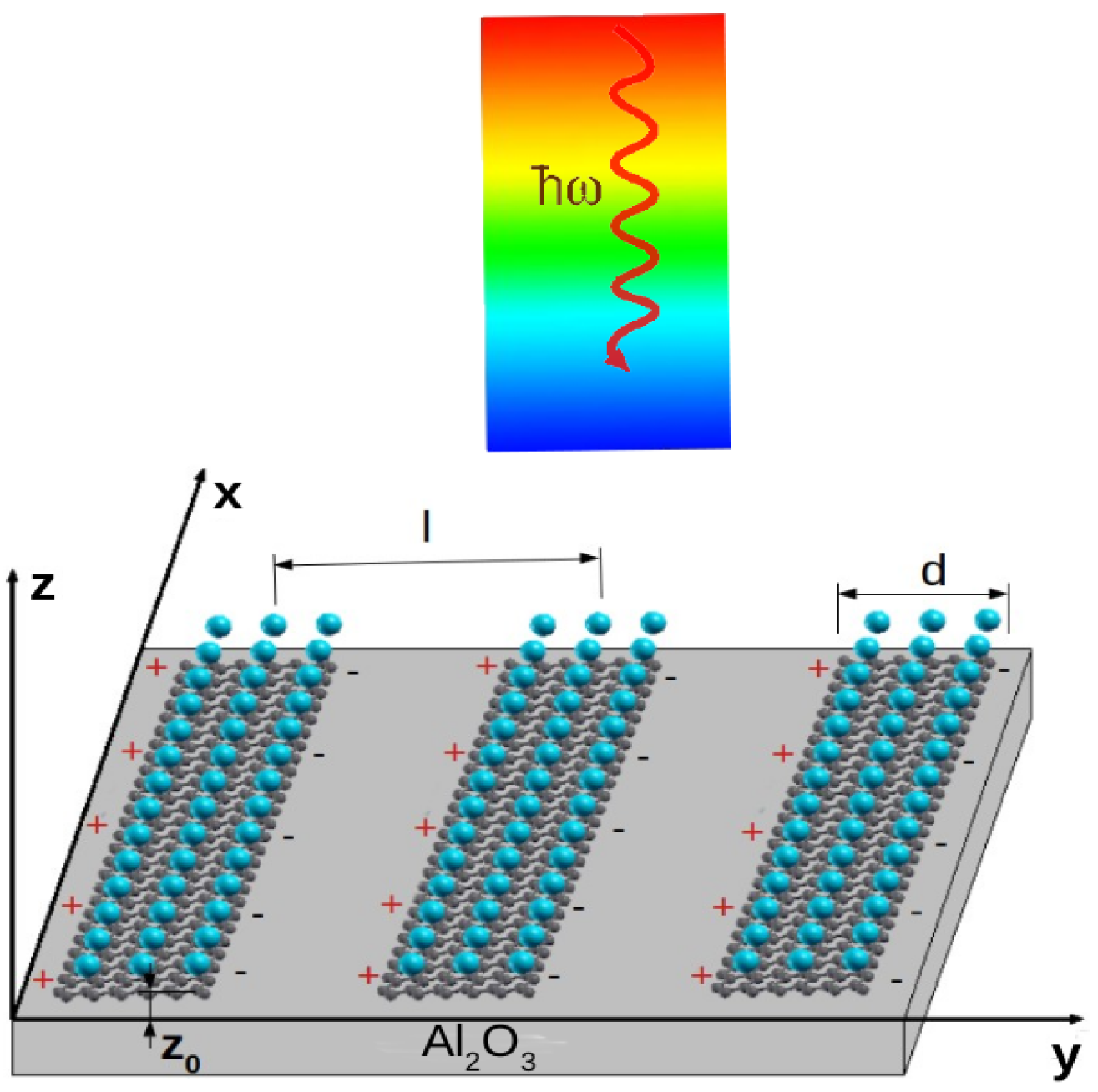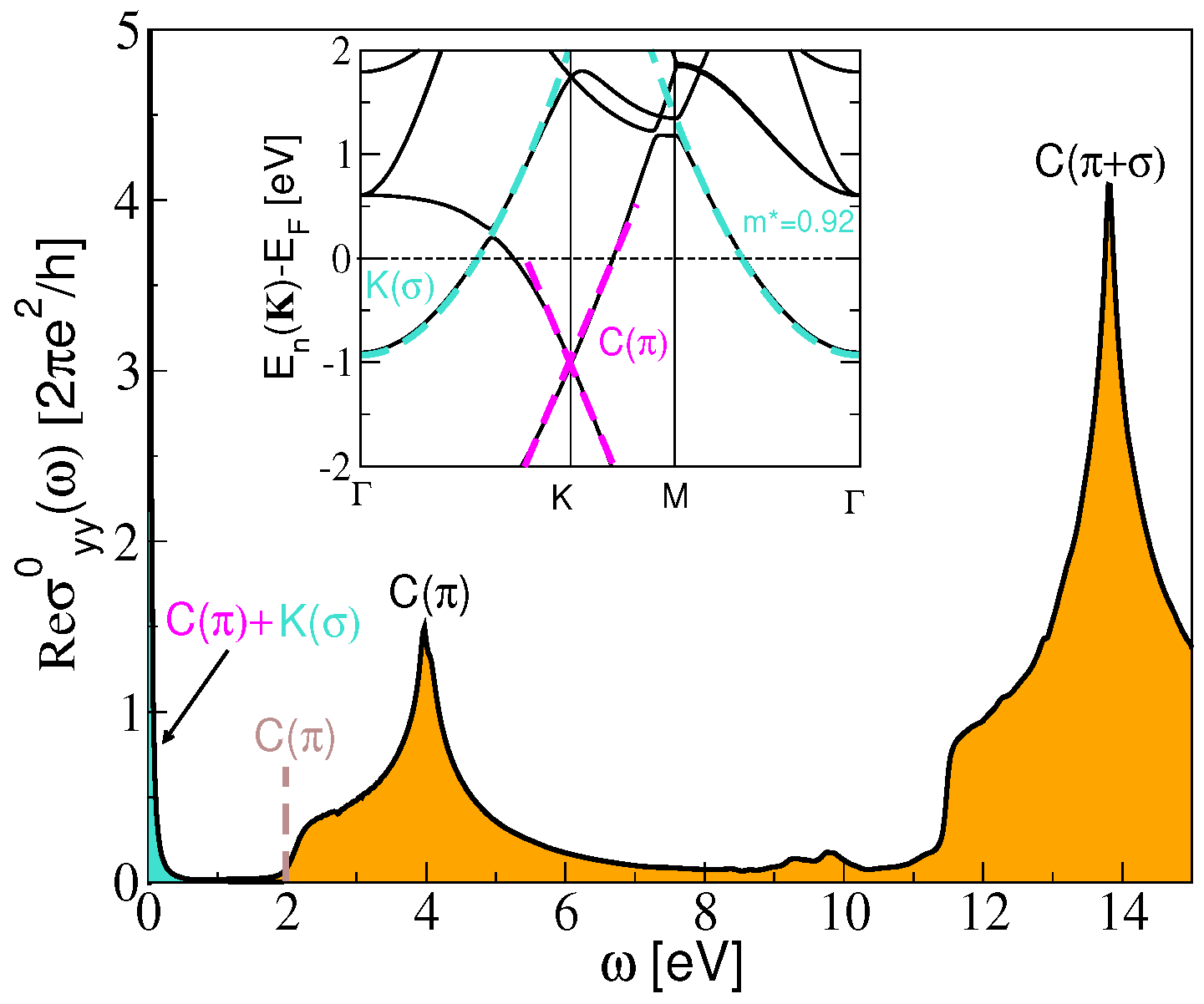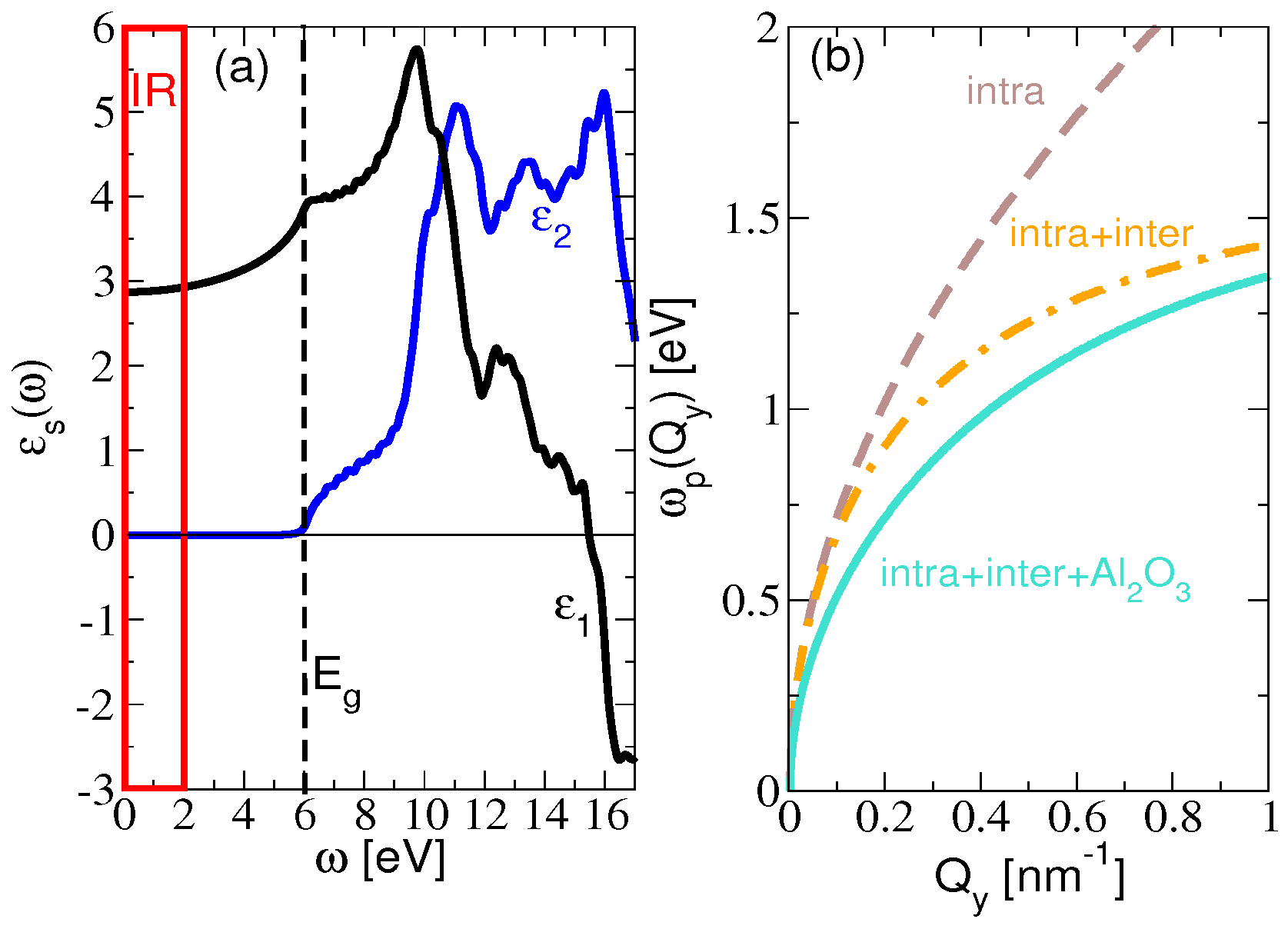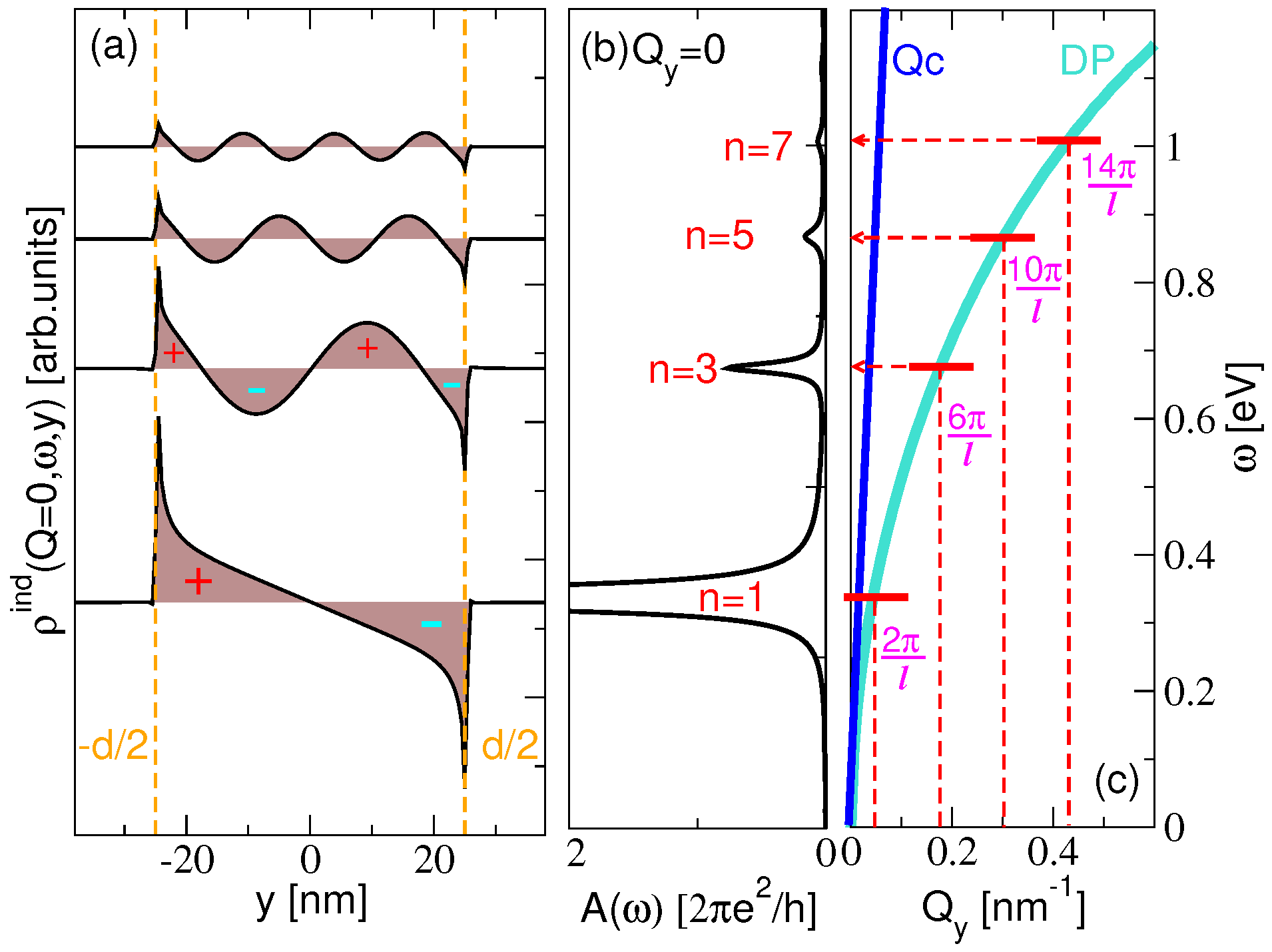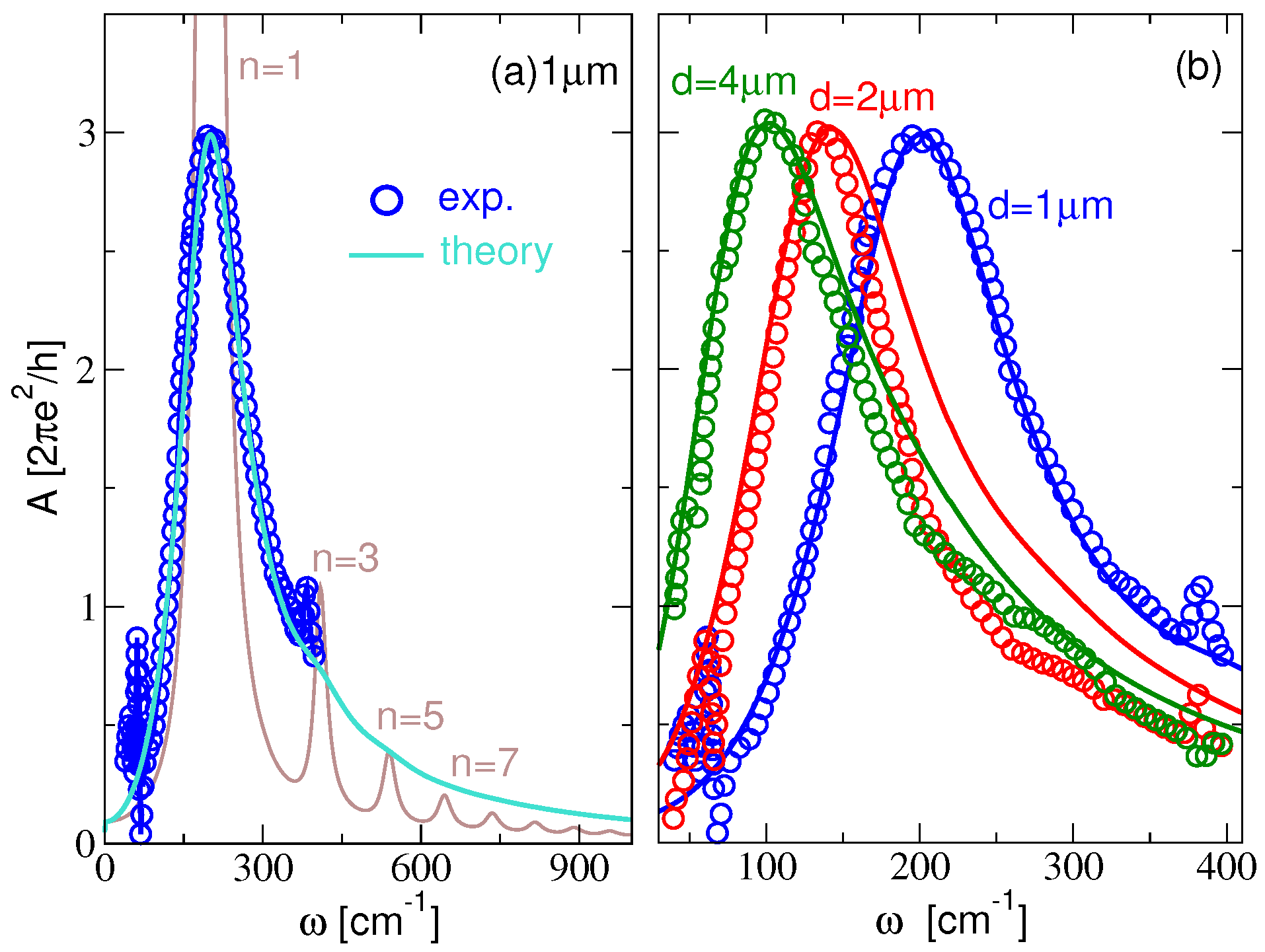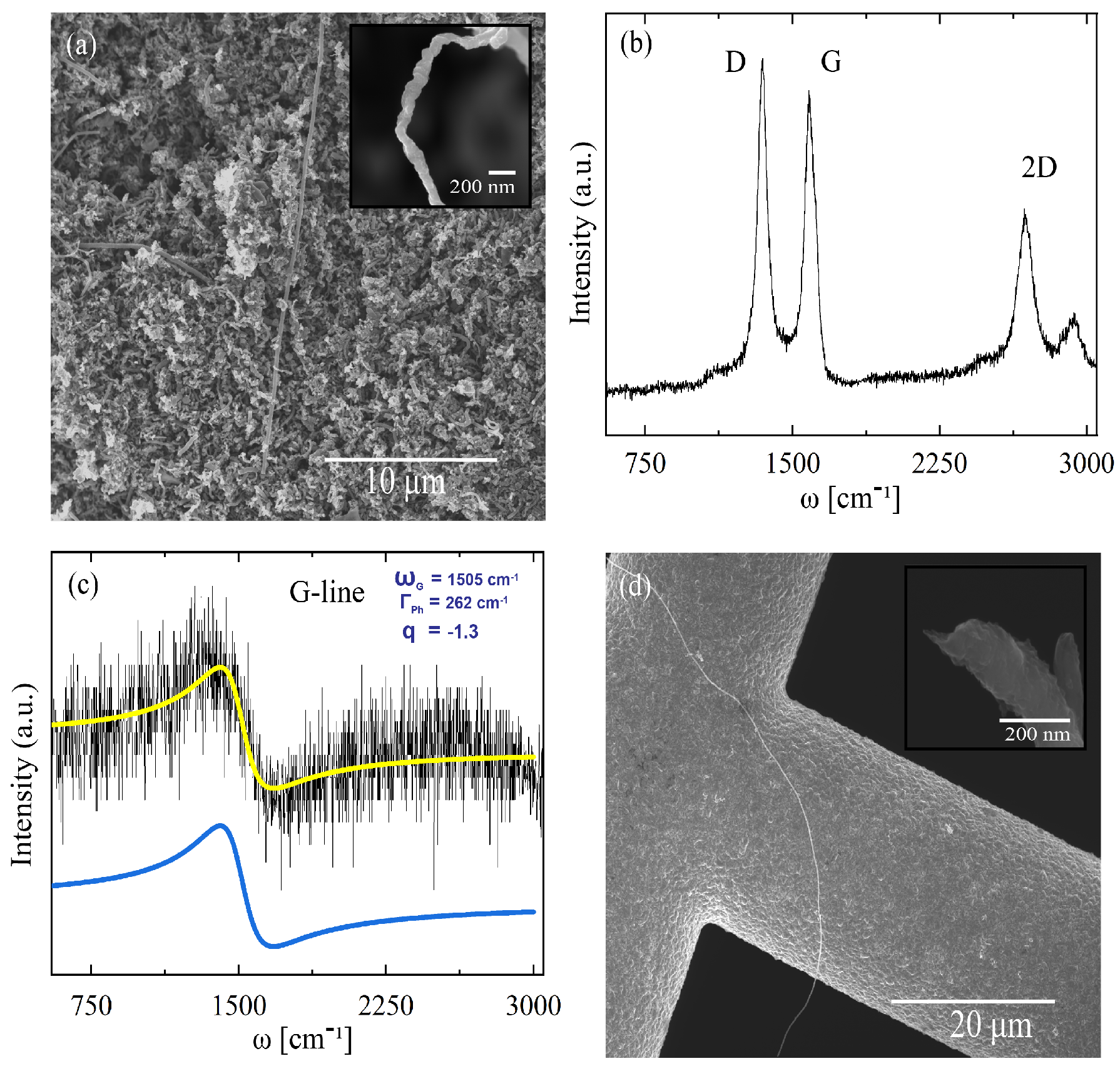1. Introduction
Recently, graphene-based plasmonics and photonics are being used in various applications, such as bio-chemical sensing enhancement [
1,
2], photovoltaic efficiency enhancements or amplification of graphene photoemission [
3,
4], in optoelectronics in the THz and the infrared (IC) frequency region and in spintronics [
5,
6]. Graphene plasmonics are also being tested for use in telecommunications [
7,
8,
9,
10,
11,
12]. Graphene-based gas detectors use localized plasmons in the graphene nanoribbons to identify the rotational-vibrational modes in various gas molecules [
13].
One of the biggest challenges in applied plasmonics or photonics is finding a way to excite and manipulate the 2D plasmons directly by the incident electromagnetic field. Even though 2D plasmons modes produce a strong localized electric field, that field is evanescent and therefore cannot be excited directly by light. In single-layer graphene, the Dirac plasmon can be excited only indirectly, e.g., by exciting the localized plasmons on the AFM tip, which then excites the Dirac plasmon in the graphene [
14]. However, subwavelength nanostructures such as graphene nanoribbons (GNRs) support ‘plasmon resonances’ with very localized electric field that can be radiated into the surrounding area; thus, it can also be pumped directly by an external radiation.
The measurements of the electromagnetic field transmission through the GNR arrays on SiO
/Si substrate clearly show the existence of strong plasmon resonances in the THz and mid-infrared frequency range (depending on nanoribbon thickness) [
15,
16]. Moreover, the infrared near-field imaging of GNRs on an Al
O
substrate shows that, in addition to the conventional plasmonic resonances, GNRs support the edge plasmons (distributed along the graphene edges [
17]). The plasmon resonances in submicrometer multilayer graphene ribbons on an Si/SiO
substrate caused by different doping concentrations (graphene Fermi energy) enable the tuning of the IR reflectivity [
18]. In the above experiments, the plasmon resonances appear in the THz and IR frequency ranges, thus hybridization with IR active Fuchs–Kliewer surface optical (SO) phonons [
19] in polar substrates was also considered.
Thus far, the theoretical description of the optically active plasmon resonances in submicrometer graphene ribbons, despite providing useful information, such as plasmon wave functions or analytical dispersion relations, is limited to semi-analytical modeling, mostly based on the simple Drude model conductivity, which does not take into account the substrate polarization [
20,
21]. The ab initio calculations of the energy loss function in semimetallic (zigzag) and semiconducting (armchair) nanoribbons [
22] provide information about the interesting interplay between the intraband and interband plasmons. The ab initio calculations of the dielectric response in different GNRs, taking into account the electron scattering with SO phonons in various polar and nonpolar substrates, provided very useful information about plasmon propagation length and plasmon–phonon hybridization [
23]. However, these ab initio studies have only focused on a few nanometers thick GNRs, while the radiative plasmon resonances were not studied. Interesting experimental and theoretical studies show that the THz absorbance of the graphene monolayer can be considerably enhanced by depositing the graphene on a dielectric substrate of specific dielectric permittivity and thickness [
24,
25]. Another very interesting phenomenon of the modulation of the THz graphene absorption is achieved by applying an optical pump signal, which modifies the conductivity of the graphene sheet [
25]. However, the sharp plasmon resonances, which occur only in graphene ribbons, are not observed in these investigations.
A way of approaching the creation of a Dirac plasmon (DP) in GNRs has been explored via the synthesis of alkali-metal-doped graphene on metallic substrates, being extensively studied experimentally and theoretically [
26,
27,
28,
29]. These experiments have shown that, by doping graphene with electron donors, the Dirac plasmon resonances can be excited and extensively studied. Furthermore, the use of advanced multilayer graphene nanoribbons will help control the plasmonic resonances derived from the perpendicular electric field in those nanostructures [
18].
In this paper, we explore the electromagnetic response in an array of potassium-doped graphene nanoribbons (KC
-NR) deposited on a (Al
O
) dielectric substrate. The single-layer KC
(KC
-SL) optical conductivity tensor
and the bulk Al
O
macroscopic dielectric function
are calculated from first principles. Special attention is paid to the series of Dirac plasmon resonances (DPR) in
, 100 and 200 nm thick KC
-NR arrays. We show that the series of DPR consists of a series of dipolar or infrared-active DPR and a series of non-dipolar or dark DPR. We demonstrate that the DPR in the first Brillouin zone (1stBZ) when unfolded in the extended Brillouin zone (exBZ) resembles the Dirac plasmon (DP) in the KC
-SL. For smaller separations between the nanoribbons, thus with a stronger interaction between, which causes dispersion, we calculate the resulting DPR band structure within the 1stBZ. Finally, we apply the proposed formulation to calculate the electromagnetic absorption in the doped graphene microribbons on the SiO
/Si surface. The results are then compared with experimental measurements of differential transmission through the same sample [
15], and KC
micrometer length GNRs intercalation compounds were synthesized.
The rest of the paper is organized as follows. In
Section 2, we present the theoretical model used to calculate the electromagnetic energy absorption
in the array of KC
-NR. In
Section 3, we present the ab initio computational details and the results for the KC
-SL optical conductivity
and the bulk Al
O
macroscopic dielectric function
. In
Section 4, we present the results for the absorption spectra
in different arrays of KC
-NR and DPR band structure. In
Section 5, we show the comparison with available experimental results.
Section 6 contains some conclusive remarks. Unless stated otherwise, atomic units are used, i.e.,
, where
e is the electronic charge,
ℏ is the reduced Plank constant,
m is the electron mass and
c is the speed of light in vacuum.
3. Computational Details
The KS wave functions
and energies
used to calculate the RPA conductivities
and the substrate macroscopic dielectric function
are determined using the plane-wave self-consistent field DFT code (PWSCF) within the QUANTUM ESPRESSO (QE) package [
34]. For all crystal structures (KC
-SL, doped graphene and bulk Al
O
), the core-electrons interaction is approximated by the norm-conserving pseudopotentials [
35,
36]. The exchange correlation (XC) potentials in the KC
-SL and Al
O
are approximated by the Perdew–Burke–Ernzerhof (PBE) generalized gradient approximation (GGA) functional [
37] and in the graphene by the Perdew–Zunger local density approximation (LDA) functional [
38]. The ground state electronic density in KC
-SL is calculated using the
Monkhorst–Pack K-mesh [
39], the plane-wave cut-off energy is 60Ry and we use the hexagonal Bravais lattice, where
Å and the separation between the KC
layers is
. Since the graphene unit cell is doped by holes, with the doping concentration
cm
, the graphene ground state electronic density is calculated using a dense
K-mesh and the plane-wave cut-off energy 60Ry. The Bravais lattices is hexagonal, where
Å and the separation between the graphene layers is
. The ground state electronic density of the bulk Al
O
is calculated using
K-mesh, the plane-wave cut-off energy is 50Ry and the Bravais lattices is hexagonal (12 Al and 18 O atoms in the unit cell) with the lattice constants
Å and
Å.
The optical conductivity (
18)–(
21) in the KC
-SL is calculated using a
K-mash and the band summations
are performed over 100 bands. The damping parameters are
meV and
meV and the temperature is
meV. The graphene optical conductivity is calculated using a
K-mash and the band summations are performed over 20 bands. The damping parameters are
and 15 meV,
meV and the temperature is
meV. The response function (
22) of the Al
O
is calculated using a
k-point mesh and the band summations
are performed over 120 bands. The damping parameter is
meV and the temperature is
meV. For the optically small wave vectors
used in this modeling, the crystal local field effects are negligible, so the crystal local field effects cut-off energy is set to zero.
Figure 2 shows the ab initio optical conductivity
in the KC
-SL. The intraband contribution
is turquoise shaded, while the interband contribution
is orange shaded. The two pronounced peaks at
and 14 eV correspond with the interband transitions between the graphene C(
) and C(
) bands. The insert in
Figure 2 shows the KC
band structure, and we can see that the KC
band structure does not differ much from the graphene band structure. The only influence of the K adatoms is the appearance of the potassium parabolic K(
) band (turquoise dashed lines show the parabolic fit of the K(
) band for the effective mass
) which abundantly donates electrons to the graphene C(
) band (denoted by magenta dashed lines) but in the way that it still remains partially filled. This causes the Fermi level shift by 1 eV above the Dirac point so that the onset for the interband transitions between the graphene C(
) bands appear at 2 eV (also denoted by brown dashed line in
Figure 2). At the same time, this causes the appearance of two intraband excitations channels, K(
and C(
), which appear as strong Drude peak (shaded by turquoise color at
). Accordingly, this provides large effective number of charge carriers,
cm
], resulting in a very intensive Dirac plasmon with zero direct interband damping.
Figure 3a shows the ab initio macroscopic dielectric function (
25) of the bulk Al
O
crystal. We can see that
is almost constant (
) for low frequencies (
eV), i.e., in the IR and even in the visible range, while
is zero up to the band gap energy (
∼6 eV). This suggests that Al
O
is a good choice for the substrate for the IR plasmonics, since its electronic excitations are far above the IR plasmons, and its IR active SO phonons (at
meV) [
40] are still below the IR plasmons considered here. Therefore, in the frequency range of interest (red frame in
Figure 3a), there is no dissipation of the electromagnetic energy in the substrate (it is transparent) and the dielectric function is constant.
Finally, in
Figure 3b, we demonstrate the influence of the KC
-SL interband transitions and the influence of the dielectric substrate polarization on the Dirac plasmon dispersion relations. The dispersion relations are derived from the maxima of the real part of the screened conductivity
for
and
(brown dashed line),
and
(orange dashed-dotted line) as well as
and
(solid turquoise line). We can see that the interband transitions significantly push the Dirac plasmon towards the lower frequencies. The substrate additionally screens the Dirac plasmon (reduces its energy), which is especially important in the optical region (
nm
) when it deviates from the standard square-root behavior in the self-standing sample.
4. Results
In this section, we first demonstrate how replacing the KC-SL by the KC-NR of various widths d influences the absorption spectra . Then, we demonstrate that the series of the Dirac plasmon resonances in the KC-NR when unfold in ExBZ resembles the Dirac plasmon in the KC-NR. Finally, we present the DPR band structure within the 1stBZ. We focus on the (perpendicular to the NR) polarized electromagnetic field, and the separation between the graphene planes and the dielectric surfaces is fixed to Å.
The blue lines in
Figure 4 show the absorption spectra (
12) of the KC
-NR arrays of widths: (a) d = 50 nm; (b) d = 100 nm; (c) d = 200 nm. The dashed orange lines show the absorption spectra of the KC
-SL. Both structures are deposited on a dielectric model Al
O
surface and the nanoribbon period is chosen to be
. We can see that, after cutting the KC
-SL into nanoribbons, the Drude asymmetric tail transforms into a series of IR-active DPR
with the energy depending on the nanoribbon width
d. As expected, as
d increases, the energy of the DPR decreases and the energy difference between them becomes smaller. Considering that the sample is driven by the electromagnetic field, homogeneous in the
y direction, the peaks appearing in the absorption spectra obviously represent optically active dipolar modes. According to the continuity equation
and
, where
is the external field given by Equation (
1), the induced density can be calculated from
. Indeed,
Figure 5a, which shows the induced electronic densities at frequencies
corresponding to the absorption peaks
in
Figure 4a, clearly demonstrates their dipolar character.
On the other hand, the induced densities of the other non-dipolar modes are zero, so they represents the dark modes, not visible in the absorption spectrum. For the period chosen here (), the separation between the nanoribbons d is quite large, and the interaction between the dipolar modes in the different nanoribbons is negligible; thus, they can be considered as almost decoupled resonances of the individual nanoribbons. However, we show below that these modes are still weakly dispersive as we increase the wave vector , suggesting their small but finite interaction.
Figure 6 shows the absorption intensities
for different wave vectors
(mostly outside the radiative region
) in the KC
-NR arrays of widths: (a)
nm; (b)
nm; (c)
nm. The figure also compares them with the absorption intensities in the KC
-SL shown in
Figure 6d. The nanoribbon period is again
. The red doted lines denote the energies of the IR active modes (
), as they appear in
Figure 4, while the turquoise doted lines denote the energies of the dark modes (
). Green dotted lines denote the dispersion relation of the Dirac plasmon in the KC
-SL. We can see that the principal mode
is the most dispersive one (within each BZ) and the most intensive in the first two BZ
. The rest of the modes,
, are less dispersive (flat patterns within some of the exBZs), and they are the most intensive through the few extended BZ, but precisely in the way that resembles the DP dispersion relation. This is particularly noticeable for the larger widths
d, as can be seen by comparing
Figure 6c,d. Moreover, we can see that the modes
in the extended BZ are ‘folded’ (although with much lower intensity) into the radiative region (
) where they become IR active. This is clearly noticeable, e.g., for the
mode in
Figure 6a–c, where just a small fraction of that mode, in exBZ, ‘projects’ into the radiative region (
). This is in accordance with the results in
Figure 4, where just the principal mode
is the most intensive, while the higher modes
are significantly suppressed.
These results show us that we can fold the fragments of the Dirac plasmon (at
) into the radiative region and make them IR-active resonances, in a controlled way, by cutting the KC
-SL into an array of nanoribbons, as sketched in
Figure 5b,c. For example, by changing the nanoribbon width, we can choose which part of the Dirac plasmon in the KC
-SL we want to fold into the radiative region. It should be noted that this procedure is also valid in the opposite direction, starting from a single nanoribbon antenna. A single nanoribbon supports nondispersive and localized (both IR active and dark) plasmon resonances, but, after the nanoribbons are arranged in a lattice, the plasmon resonances unfold over the extended BZ resembling the DP, regardless of the period
l. All these manipulations are experimentally feasible, which could have a significant impact on the applied plasmonics.
DPR Band Structure
We now analyze the dispersion relations of the DPR within the 1stBZ, , i.e., the DPR band structure. In the previous examples, the separation between the nanoribbons is quite large, so the coupling between the DPR in the different ribbons is weak and, consequently, the DPR are weakly dispersive within the 1stBZ. However, we show above that the dispersion across the exBZs is strong so that it resembles the Dirac plasmon in the KC-SL. The origin of this dispersivity is simple: for larger wave vector , the spatial variation of the external field partially or fully fits the spatial variation (or symmetry) of higher excited modes , regardless of whether they are dipolar or non-dipolar modes, and finally it efficiently excites these modes. On the other hand, the homogenous external field () selectively and quite inefficiently excites the higher dipolar modes Therefore, the inter-zonal dispersivity always exists, even though the interaction between the ribbons is negligible. However, for smaller separations, the interaction between the nanoribbons is getting stronger and DPRs become dispersive within the 1stBZ (or within some individual exBZ).
Figure 7 shows the absorption intensities
in the KC
-NR array deposited on the Al
O
surface for different wave vectors
1stBZ. The nanoribbon width is
nm and the period is
nm. The photon dispersion
is also shown (green dotted lines) in order to denote the radiative region
. It can be noticed that this small separation (
nm) causes substantial dispersivity of the principal
mode, resulting with the band width of about
meV and the band gap opening of about
meV. The higher DPR (
) are less dispersive, probably because they produce short-ranged electric field so the inter-ribbon interaction is weaker. It is interesting that the dark mode
seems to split into two branches as
decreases. This may be the evidence of the surface or ‘edge’ plasmons localized at the KC
-NR boundaries [
17]. The edge plasmons are the counterparts of the standard surface plasmons appearing on metal surfaces. They are the extra solutions of the Maxwell’s equation, due to the symmetry breaking caused by the edge, and have an evanescent character, in contrast to the DPR which oscillate across the nanoribbon (see
Figure 5a). The DPR band-gap can be manipulated by changing the KC
-NR parameters which opens the possibility for trapping the photons in the principal
band and achieving the Dirac plasmon Bose–Einstein condensate. Therefore, the doped graphene nanoribbons enable direct light–plasmon interaction, which can be exploited in many plasmonic or photonics applications, while at the same time it can serve as a polygon for exploring fundamental physical phenomena such as strong light–matter interactions, which has been intensively explored recently [
41].
5. Comparison with Experiment
In order to verify the accuracy and experimental feasibility of the above results, we compare them with some recent experimental results. Since optical absorption experiments on the KC
-NR arrays still do not exist, we compare our results with the experimental results for the differential transmission
through the array of doped graphene micro-ribbons on Si/SiO
substrate [
15], where
is the transmission coefficient through the device at the charge neutral point (CNP).
is directly related to our infrared absorption spectrum
. In our calculations, the graphene is doped by holes, where the hole concentration is chosen to be
cm
[
15] (
eV with respect to the Dirac point). The Si/SiO
substrate is described by the dielectric constant
, which is between
in SiO
and
in Si. The separation between the graphene and the SiO
surface is taken to be
Å [
42].
In order to gain insight into the measured data for wider energy range, in
Figure 8a, we compare the experimental result for
(blue circles) with our results for
calculated for two intraband damping parameters
meV (brown line) and
meV (turquoise line) and on extended frequency scale. The graphene ribbon width is
m and the period is
m. We can see that for the smaller damping parameters absorption spectra shows DPR
, which for the larger damping smooth out into an asymmetrical lineshape which is in excellently agreement with the experimental data. Therefore, we can conclude that the experimental lineshape mainly consists of the principal dipolar mode
, and its asymmetry is a consequence of the excitations of higher-order dipolar modes
Figure 8b shows the theoretical absorption spectra
in an array of graphene ribbons of widths
m (blue line), 2
m (red line) and 4
m (green line) and compares them with the experimental results for
(blue, red and green circles). The period is
. These results undoubtedly confirm that the broad experimental peaks corresponds to the
DPR, while the higher-order dipolar DPR
give the spectrum an asymmetric shape. Moreover, these results determine the natural intraband damping parameter
meV, which is a consequence of the electron–phonon (instrinsic and SO phonons) interactions, scattering on impurities and other crystal imperfections.
All this suggests that the electron–phonon interaction (or maybe some other scattering mechanisms) is likely to play a significant role in profiling the higher-order plasmon resonances
n = 3, 5, …. Below, we show that the synthesis of the potassium intercalated graphene (KC
) ribbons is indeed possible and explore how the potassium adatoms influence the strength of the electron–phonon coupling. The latter is very important because alkali metals can sometimes increase and sometimes decrease the strength of the electron coupling to the graphene E
phonon [
43], which is, as already mentioned, very important for the damping of the plasmon resonances.
Our scanning electron microscopy (SEM) analysis of GNRs placed on a carbon tape and analyzed with 5 kV Helios NanoLab DualBeam scanning electron microscope showed multilayer GNR structures with lengths of several microns and widths ranging around 100 nm.
Figure 9a confirms a flat-rippled multilayer nanoribbon morphology. These GNRs were synthesized via CVD following the procedure described in [
44] and further intercalated by conducting a two-zone vapor transport method, as described in [
45]. The intercalation compounds was obtained by the combination of an alkali metal (K) placed in a glass vial with GNRs sealed under high vacuum conditions at 10
mbar in a proportion of 3.2 mg of GNRs per 1.3 mg of potassium (∼KC
GNRIC). The characteristic Raman spectrum from the GNRs (
Figure 9b–i) revealed the characteristic D-band and G-band located at ∼1338 cm
and ∼1574 cm
, respectively. The D-band exhibited a larger intensity caused by the edge ripple proportion, while the D/G ratio was found to be 1.25 characteristic of graphene nanoribbons [
44]. At ∼2674 cm
, we observed the 2D-line characteristic of graphitic GNRs [
44,
46]. An intercalation process using the discussed pristine sample was performed obtaining a KC
GNRIC. This sample was kept under vacuum conditions to avoid oxidation during the Raman measurements. The Raman spectrum obtained from the KC
GNRIC in
Figure 9c shows the characteristic broad Fano-line-shape composed by a G-line at ∼1505 cm
caused by the intercalation of potassium layers in between the graphene ribbons. This characteristic G-line in intercalation compounds originates from strong electron–phonon coupling (EPC) interactions existing between the potassium atoms and the graphene layers, as we reported previously for graphite intercalation compounds [
47]. It is proven that by doping graphene with electron donors the Dirac plasmon resonances can be excited [
18]. Thus, here we could introduce the fact that, by obtaining a highly e
-doped intercalation compound (i.e., KC
), we must obtain: (i) a strong EPC that will be responsible for superconductivity in stage I GICs according to the BCS theory directly related to the G-line phonon frequency and to the adiabatic (
) and non-adiabatic (
) phonon frequencies of the GIC; (ii) a strong EPC in GNRIC will serve to excite plasmonic resonances derived from the perpendicular electric field in those nanostructures. To estimate the renormalized electron–phonon scattering line width (
) in GNRIC, we consider the G-line phonon frequency (
from
) of the Raman spectrum in
Figure 9c in the following equation [
47]:
where
is the measured G-line frequency from the Fano function (1505 cm
),
is the adiabatic phonon frequency (1223 cm
) and
corresponds to the non-adiabatic phonon frequency (1534 cm
) [
48]. From this equation we obtained,
243 cm
for KC8 GNRIC is indicative of a potential superconducting behavior of the material as it behaves linearly with the measured FWHM (
262 cm
). An individualized GNRIC can be evinced in
Figure 9d to confirm no further damage to the structure of the graphitic ribbon.
Finally, our theoretical results are in excellent agreement with the experimental results, confirming the credibility of the presented method and the above-stated conclusions.
